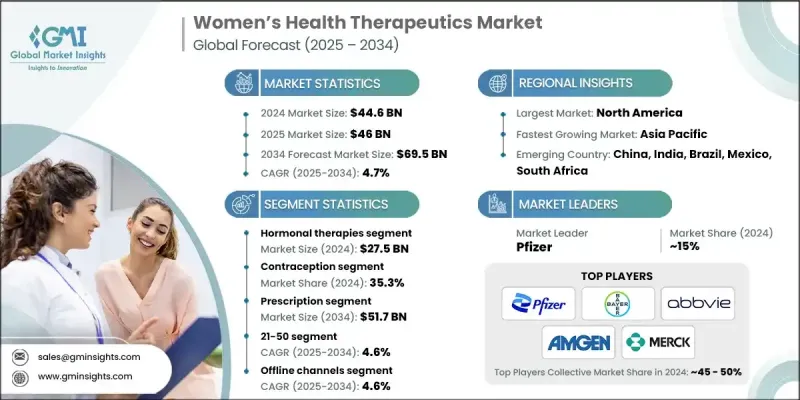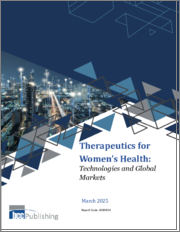
|
시장보고서
상품코드
1833436
여성 건강 치료제 시장 기회와 촉진요인, 산업 동향 분석 및 예측(2025-2034년)Womens Health Therapeutics Market Opportunity, Growth Drivers, Industry Trend Analysis, and Forecast 2025 - 2034 |
||||||
세계의 여성 건강 치료제 시장은 2024년에는 446억 달러로 평가되었고, CAGR 4.7%로 성장하여 2034년에는 695억 달러에 이를 것으로 추정되고 있습니다.

자궁내막증, 폐경, 다낭성난소증후군(PCOS), 골다공증 등의 질환이 점점 더 흔해지고 있습니다. 이러한 질병 부담 증가는 보다 효과적이고 표적화된 치료제에 대한 수요를 증가시키고 있습니다.
| 시장 범위 | |
|---|---|
| 개시 연도 | 2024년 |
| 예측 연도 | 2025-2034년 |
| 시장 규모 | 446억 달러 |
| 예측 금액 | 695억 달러 |
| CAGR | 4.7% |
호르몬 요법 도입 증가
호르몬 치료 분야는 갱년기 장애, 자궁내막증, 호르몬 균형 장애 등의 증상에 대한 치료 수요 증가로 인해 2024년 큰 점유율을 차지할 것으로 예측됩니다. 호르몬 대체 요법(HRT)과 치료되지 않은 호르몬 문제가 건강에 미치는 장기적인 영향에 대한 인식이 높아짐에 따라, 점점 더 많은 여성들이 의료적 개입을 요구하고 있습니다. 이 시장에서는 패치, 젤, 서방형 임플란트 등 환자 순응도를 높일 수 있는 전달 메커니즘의 혁신이 계속되고 있습니다.
피임 보급률 증가
피임 분야는 장기 지속형 가역적 피임약(LARC)과 비호르몬 피임약에 대한 수요 증가로 인해 2024년 큰 점유율을 차지할 것으로 예측됩니다. 현대인의 라이프스타일, 가족계획의 지연, 생식 자율성에 대한 공중보건적 지원 증가는 다양한 계층에 대한 보급에 박차를 가하고 있습니다. 시장은 기존의 경구피임약에 그치지 않고 질링, 자궁내피임기구(IUD), 피임주사제 등 혁신적인 제품들로 진화하고 있습니다.
처방약에 의한 견인
골다공증, 불임, 부인과 암 등의 치료에는 임상적 특성이 있기 때문에 2024년에는 처방약 부문이 큰 비중을 차지할 것으로 예측됩니다. 의사는 여전히 중요한 의사결정권자이며, 처방된 의약품에 대한 환자의 신뢰는 브랜드 충성도를 지속적으로 견인하고 있습니다. 규제 당국의 승인 경로, 포뮬러의 포지셔닝, 보험 적용은 이 부문의 매출 실적에 큰 영향을 미칩니다.
북미는 추진력 있는 지역으로
북미 여성 건강 치료제 시장은 2025년부터 2034년까지 적절한 CAGR로 성장할 것으로 예측됩니다. 이 지역은 선진적인 의료 인프라, 강력한 규제 감독, 환자와 의료 제공업체 모두의 높은 의식 수준 등의 이점을 누리고 있습니다. 시장 참여자들은 유리한 상환 정책과 사춘기부터 폐경 후까지 여성의 생애주기별 단계별 표적 치료에 대한 수요 증가를 활용하고 있습니다.
여성 건강 치료제 시장의 주요 기업은 Theramex, Cipla, Kissei Pharmaceuticals, Evofem, Pfizer, Shionogi, Ferring, Organon, Amgen, Besins, Allergan(AbbVie), Sanofi, Gedeon Richter, Lupin Atossa Therapeutics,Novartis,Johnson &Johnson,Bayer입니다.
여성 건강 치료 분야 시장 기반을 강화하기 위해 각 업체들은 다각적인 접근에 주력하고 있습니다. 주요 전략으로는 특히 자궁근종, 여성 성기능 장애 등 치료제가 부족한 질환에 대한 자체 연구개발 및 라이선스 계약을 통한 제품 파이프라인 확대가 있습니다. M&&A 또한 시장에서의 존재감을 높이고 혁신적인 기술에 대한 접근성을 확보하기 위해 활용되고 있습니다.
목차
제1장 조사 방법과 범위
제2장 주요 요약
제3장 업계 인사이트
- 생태계 분석
- 공급업체 상황
- 각 단계에서의 부가가치
- 밸류체인에 영향을 미치는 요인
- 업계에 대한 영향요인
- 성장 촉진요인
- 만성질환 및 생활습관병 이환율 상승
- 교육과 공중위생 캠페인 강화
- 맞춤형 의료 진보
- 월경 건강과 위생에 관한 치료제 수요 증가
- 업계의 잠재적 리스크&과제
- 월경, 불임, 갱년기에 관한 사회적 편견
- 치료비가 높은
- 규제상 과제
- 시장 기회
- 신흥 시장에의 확대
- 여성 예방 헬스케어에 대한 주목이 높아진다
- 성장 촉진요인
- 성장 가능성 분석
- 규제 상황
- 파이프라인 분석
- 여성 건강 분야 투자 및 자금조달 상황
- 기술적 상황
- 향후 시장 동향
- Porter의 Five Forces 분석
- PESTEL 분석
제4장 경쟁 구도
- 서론
- 기업 매트릭스 분석
- 기업의 시장 점유율 분석
- 주요 시장 기업의 경쟁 분석
- 경쟁 포지셔닝 매트릭스
- 주요 발전
- 인수합병(M&A)
- 파트너십 및 협업
- 신제품 발매
- 확장 계획
제5장 시장 추산·예측 : 약제 유형별, 2021-2034
- 주요 동향
- 호르몬 요법
- 통증과 증상 관리약
- GnRH 모듈레이터
- 뼈 건강 촉진제
- 대사약
- 불임 치료제
- 기타 약물 유형
제6장 시장 추산·예측 : 용도별, 2021-2034
- 주요 동향
- 피임
- 갱년기와 폐경 후 관리
- 호르몬 장애
- 자궁내막증과 자궁근종
- 생식 보건과 불임 치료
- 뼈 건강과 골다공증
- 기타 용도
제7장 시장 추산·예측 : 약 유형별, 2021-2034
- 주요 동향
- 시판약(OTC)
- 처방전
제8장 시장 추산·예측 : 연령별, 2021-2034
- 주요 동향
- 20세 미만
- 21-50
- 51세 이상
제9장 시장 추산·예측 : 유통 채널별, 2021-2034
- 주요 동향
- 오프라인 채널
- 병원 약국
- 소매 약국
- 기타 오프라인 스토어
- 온라인 채널
제10장 시장 추산·예측 : 지역별, 2021-2034
- 주요 동향
- 북미
- 미국
- 캐나다
- 유럽
- 독일
- 영국
- 프랑스
- 이탈리아
- 스페인
- 네덜란드
- 아시아태평양
- 중국
- 일본
- 인도
- 호주
- 한국
- 라틴아메리카
- 브라질
- 멕시코
- 아르헨티나
- 중동 및 아프리카
- 남아프리카공화국
- 사우디아라비아
- 아랍에미리트
제11장 기업 개요
- Allergan(AbbVie)
- Amgen
- Atossa Therapeutics
- Bayer
- Besins
- Cipla
- Evofem
- Ferring
- Gedeon Richter
- Johnson &Johnson
- Kissei Pharmaceutical
- Lupin
- Novartis
- Organon
- Pfizer
- Sanofi
- Shionogi
- Theramex
The Global Womens Health Therapeutics Market was valued at USD 44.6 billion in 2024 and is estimated to grow at a CAGR of 4.7% to reach USD 69.5 billion by 2034.

Conditions like endometriosis, menopause-related issues, polycystic ovary syndrome (PCOS), and osteoporosis is increasingly common. This growing disease burden is pushing demand for more effective and targeted therapeutics.
| Market Scope | |
|---|---|
| Start Year | 2024 |
| Forecast Year | 2025-2034 |
| Start Value | $44.6 Billion |
| Forecast Value | $69.5 Billion |
| CAGR | 4.7% |
Increasing Adoption of Hormonal Therapies
The hormonal therapies segment held a significant share in 2024, driven by the rising demand for treatments that address conditions such as menopause symptoms, endometriosis, and hormonal imbalances. As awareness grows around hormone replacement therapy (HRT) and the long-term health impacts of untreated hormonal issues, more women are seeking medical intervention. The market has seen continuous innovation in delivery mechanisms, including patches, gels, and sustained-release implants, which enhance patient compliance.
Rising Prevalence of Contraception
The contraception segment generated a sizeable share in 2024, driven by rising demand for both long-acting reversible contraceptives (LARCs) and non-hormonal options. Modern lifestyles, delayed family planning, and growing public health support for reproductive autonomy have fueled adoption across a broad demographic. The market is evolving beyond traditional oral contraceptives, with innovations in vaginal rings, intrauterine devices (IUDs), and injectable formats.
Prescription to Gain Traction
The prescription segment held a substantial share in 2024, owing to the clinical nature of most treatments for conditions like osteoporosis, fertility issues, and gynecological cancers. Physicians remain key decision-makers, and patient trust in prescribed medications continues to drive brand loyalty. Regulatory approval pathways, formulary positioning, and insurance coverage significantly impact sales performance in this segment.
North America to Emerge as a Propelling Region
North America womens health therapeutics market is poised to grow at a decent CAGR during 2025-2034. The region benefits from advanced healthcare infrastructure, strong regulatory oversight, and high awareness levels among both patients and providers. Market players are capitalizing on favorable reimbursement policies and rising demand for targeted treatments across various stages of a woman's life cycle, from adolescence to post-menopause.
Major players in the women's health therapeutics market are Theramex, Cipla, Kissei Pharmaceutical, Evofem, Pfizer, Shionogi, Ferring, Organon, Amgen, Besins, Allergan (AbbVie), Sanofi, Gedeon Richter, Lupin, Atossa Therapeutics, Novartis, Johnson & Johnson, and Bayer.
To strengthen their market foothold in the women's health therapeutics space, companies are focusing on a multi-pronged approach. Key strategies include expanding product pipelines through in-house R&D and licensing deals, particularly for underserved conditions such as uterine fibroids and female sexual dysfunction. Mergers and acquisitions are also being used to consolidate market presence and gain access to innovative technologies.
Table of Contents
Chapter 1 Methodology and Scope
- 1.1 Market scope and definition
- 1.2 Research design
- 1.2.1 Research approach
- 1.2.2 Data collection methods
- 1.3 Data mining sources
- 1.3.1 Global
- 1.3.2 Regional/country
- 1.4 Base estimates and calculations
- 1.4.1 Base year calculation
- 1.4.2 Key trends for market estimation
- 1.5 Primary research and validation
- 1.5.1 Primary sources
- 1.6 Forecast model
- 1.7 Research assumptions and limitations
Chapter 2 Executive Summary
- 2.1 Industry 360° synopsis
- 2.2 Key market trends
- 2.2.1 Regional
- 2.2.2 Drug type
- 2.2.3 Application
- 2.2.4 Medication type
- 2.2.5 Age group
- 2.2.6 Distribution channel
- 2.3 CXO perspectives: Strategic imperatives
- 2.3.1 Key decision points for industry executives
- 2.3.2 Critical success factors for market players
- 2.4 Future outlook and strategic recommendations
Chapter 3 Industry Insights
- 3.1 Industry ecosystem analysis
- 3.1.1 Supplier landscape
- 3.1.2 Value addition at each stage
- 3.1.3 Factors affecting the value chain
- 3.2 Industry impact forces
- 3.2.1 Growth drivers
- 3.2.1.1 Rising prevalence of chronic and lifestyle diseases
- 3.2.1.2 Enhanced education and public health campaigns
- 3.2.1.3 Growing advancement in personalized medicine
- 3.2.1.4 Increasing demand for menstrual health and hygiene therapeutics
- 3.2.2 Industry pitfalls and challenges
- 3.2.2.1 Social stigma around menstruation, infertility, and menopause
- 3.2.2.2 High treatment cost
- 3.2.2.3 Regulatory challenges
- 3.2.3 Market opportunities
- 3.2.3.1 Expansion in emerging markets
- 3.2.3.2 Growing focus on preventive women's healthcare
- 3.2.1 Growth drivers
- 3.3 Growth potential analysis
- 3.4 Regulatory landscape
- 3.4.1 North America
- 3.4.2 Europe
- 3.4.3 Asia Pacific
- 3.4.4 Latin America
- 3.4.5 Middle East and Africa
- 3.5 Pipeline analysis
- 3.6 Investment and funding landscape in the women's health sector
- 3.7 Technological landscape
- 3.8 Future market trends
- 3.9 Porter’s analysis
- 3.10 PESTEL analysis
Chapter 4 Competitive Landscape, 2024
- 4.1 Introduction
- 4.2 Company matrix analysis
- 4.3 Company market share analysis
- 4.4 Competitive analysis of major market players
- 4.5 Competitive positioning matrix
- 4.6 Key developments
- 4.6.1 Merger and acquisition
- 4.6.2 Partnership and collaboration
- 4.6.3 New product launches
- 4.6.4 Expansion plans
Chapter 5 Market Estimates and Forecast, By Drug Type, 2021 - 2034 ($ Mn)
- 5.1 Key trends
- 5.2 Hormonal therapies
- 5.3 Pain and symptom management drugs
- 5.4 GnRH modulators
- 5.5 Bone health agents
- 5.6 Metabolic drugs
- 5.7 Fertility drugs
- 5.8 Other drug types
Chapter 6 Market Estimates and Forecast, By Application, 2021 - 2034 ($ Mn)
- 6.1 Key trends
- 6.2 Contraception
- 6.3 Menopause and post-menopausal management
- 6.4 Hormonal disorders
- 6.5 Endometriosis and uterine fibroids
- 6.6 Reproductive health and fertility care
- 6.7 Bone health and osteoporosis
- 6.8 Other applications
Chapter 7 Market Estimates and Forecast, By Medication Type, 2021 - 2034 ($ Mn)
- 7.1 Key trends
- 7.2 Over the counter (OTC)
- 7.3 Prescription
Chapter 8 Market Estimates and Forecast, By Age Group, 2021 - 2034 ($ Mn)
- 8.1 Key trends
- 8.2 Below 20
- 8.3 21-50
- 8.4 51 and above
Chapter 9 Market Estimates and Forecast, By Distribution Channel, 2021 - 2034 ($ Mn)
- 9.1 Key trends
- 9.2 Offline channels
- 9.2.1 Hospital pharmacies
- 9.2.2 Retail pharmacies
- 9.2.3 Other offline stores
- 9.3 Online channels
Chapter 10 Market Estimates and Forecast, By Region, 2021 - 2034 ($ Mn)
- 10.1 Key trends
- 10.2 North America
- 10.2.1 U.S.
- 10.2.2 Canada
- 10.3 Europe
- 10.3.1 Germany
- 10.3.2 UK
- 10.3.3 France
- 10.3.4 Italy
- 10.3.5 Spain
- 10.3.6 Netherlands
- 10.4 Asia Pacific
- 10.4.1 China
- 10.4.2 Japan
- 10.4.3 India
- 10.4.4 Australia
- 10.4.5 South Korea
- 10.5 Latin America
- 10.5.1 Brazil
- 10.5.2 Mexico
- 10.5.3 Argentina
- 10.6 Middle East and Africa
- 10.6.1 South Africa
- 10.6.2 Saudi Arabia
- 10.6.3 UAE
Chapter 11 Company Profiles
- 11.1 Allergan (AbbVie)
- 11.2 Amgen
- 11.3 Atossa Therapeutics
- 11.4 Bayer
- 11.5 Besins
- 11.6 Cipla
- 11.7 Evofem
- 11.8 Ferring
- 11.9 Gedeon Richter
- 11.10 Johnson & Johnson
- 11.11 Kissei Pharmaceutical
- 11.12 Lupin
- 11.13 Novartis
- 11.14 Organon
- 11.15 Pfizer
- 11.16 Sanofi
- 11.17 Shionogi
- 11.18 Theramex



















